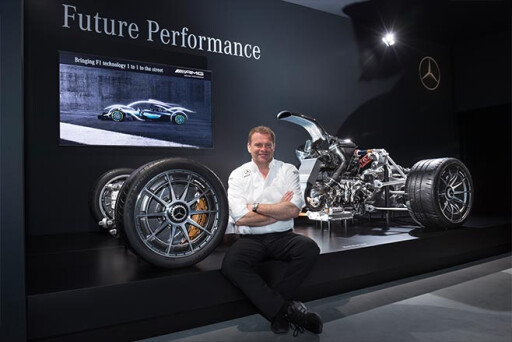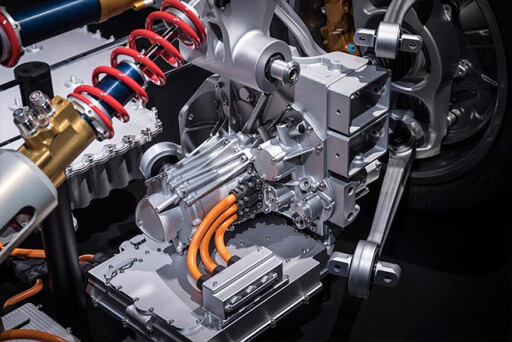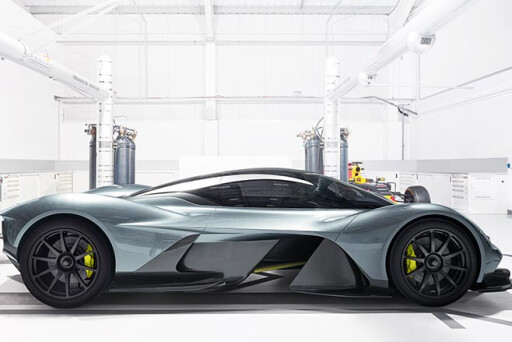
Mercedes-AMG is attempting to do what no other manufacturer has managed, install a Formula 1 engine in a road-going production car.
Nestled midships in AMG’s forthcoming hypercar, codenamed Project One, is, in essence, the same turbocharged V6 that has powered Mercedes F1 cars to three straight drivers’ and constructors’ titles.
First presented as an idea at the 2016 Paris Motor Show, ahead of the recent Nurburgring 24-Hour AMG boss Tobias Moers went into more detail about the ambitious project alongside a static model of the Project One’s mechanical layout.

The powertrain is incredibly complicated, incorporating a 1.6-litre turbocharged V6 capable of revving to 11,000rpm, aided by a 120kW electric motor on each front wheel, another 100kW electric motor attached to the crankshaft and a final 80kW electric motor driving the turbocharger for immediate response.
Powering the electric motors will be 100kg of lithium-ion batteries nestled behind the front wheels which use the same cell technology as the F1 car, though with four times the storage capacity.
Combined system output is claimed to be more than 735kW (1000hp) and despite the heavy reliance on electricity, the hybrid component exists almost purely to boost performance, with Project One expected to have an electric-only range of just 25km. The V6 itself will have a life of around 50,000km before major work is required, according to AMG boss Tobias Moers.

Due to the incredibly high-revving nature of the engine, Mercedes has had to revert to an automated manual gearbox such as that in the Lexus LFA, as no dual-clutch or torque-converter automatic is capable of handling such high rpm. All up, the powertrain weighs 420kg and will propel the car to around 350km/h, though top speed is not a development priority.
Instead, “outstanding dynamic driving capability” is the design target according to Moers. The engine and gearbox are fully stressed parts of the chassis, while Project One uses five-link suspension at both ends with electronically-controlled inboard coilover suspension.
There will be a number of drive modes, the most aggressive, track-focused of which drops the car to the ground to make best use of the active aerodynamics.

Total weight is predicted to be around 1300kg, while the front electric motors will not only provide all-wheel drive functionality but also the ability to individually control each front wheel in the ultimate example of torque vectoring, dubbed AMG Torque Dynamics.
Tyres are bespoke Michelin Pilot Sport Cup 2s measuring a whopping 335/30 at the rear and 285/35 front, wrapped around staggered rim sizes (19-inch front; 20-inch rear).
Just 275 Project Ones will be built with a price tag of 2million Euros and currently nine of those will be coming to Australia, with Mercedes-Benz Australia battling to increase its local allocation as it holds a further seven expressions of interest.

The first customer cars are expected to be delivered in 2019 with all cars delivered by the end of 2020.
Questions remains as to how AMG will manage to make the engine meet international sound and emissions regulations and produce acceptable levels of noise, vibration and harshness, not to mention get it to idle at 1100rpm rather than the 3500-4000rpm of the F1 car.
These details and more, including the car’s styling, will be revealed at the car’s public debut at the Frankfurt Motor Show in December.

The rivals
Ultra-exclusive hypercars like the Project One might traditionally be all spoken for before production begins, however as the ultimate expression of their respective makers’ engineering might, it’s arguably even more important to be seen to be the best.
The Project One’s main competition will come from the Aston Martin Valkyrie, a car with a similar F1 connection. Red Bull Racing’s aero wizard Adrian Newey is the brains behind the project and Aston claims on slicks the car will be able to lap at 2016 F1 race pace.

Similar in concept to the Project One, the Valkyrie takes a very different tack, with a monster 662kW V12 in a chassis that will weigh only around 1000kg. Just 150 road versions and 25 track cars are planned with deliveries to start in 2019.
Also landing in 2019 is the McLaren BP23, a three-seater homage to the original F1. Far more road-focused than either the Project One or Valkyrie, McLaren nonetheless claims the BP23 (not its final title) will be the fastest car it’s ever built. The world’s billionaires have never had it so good.

COMMENTS